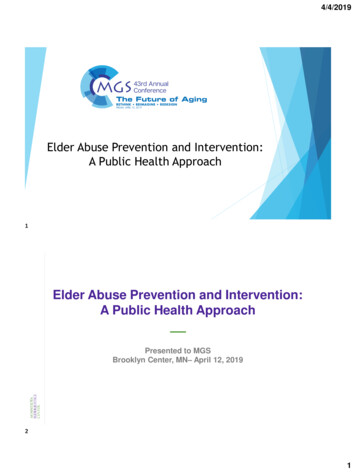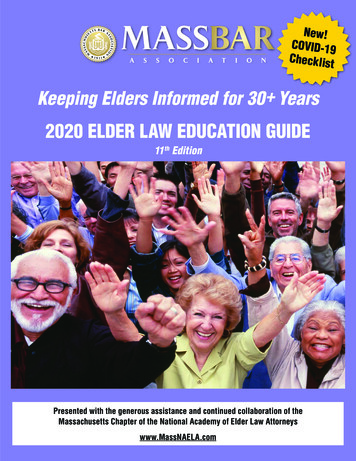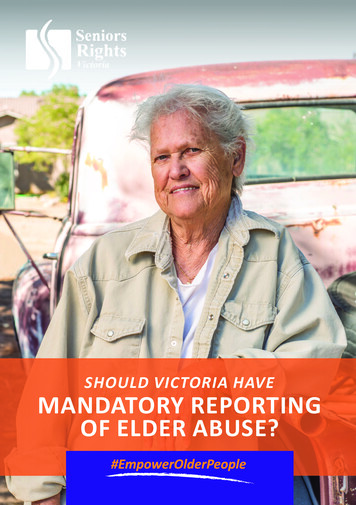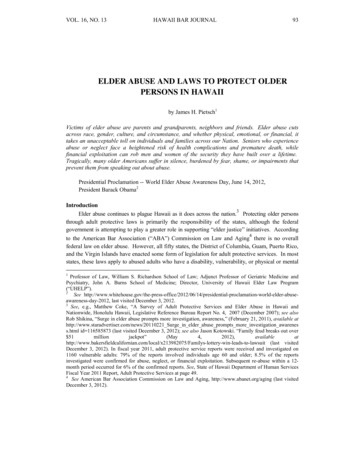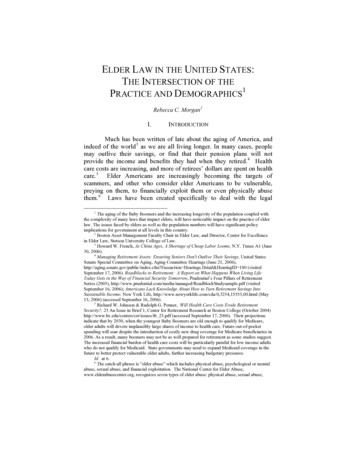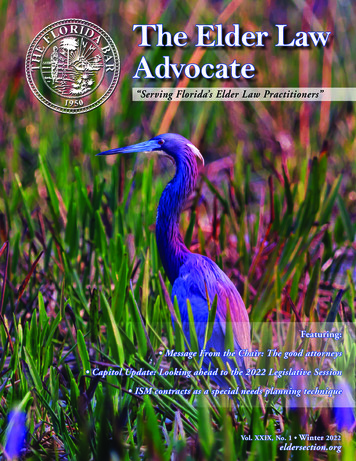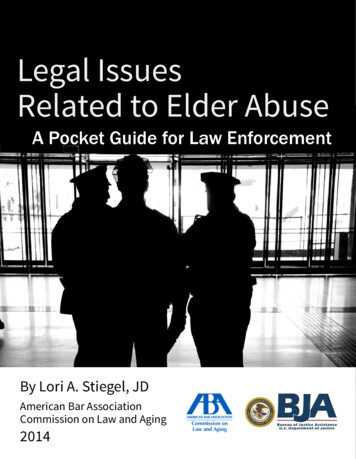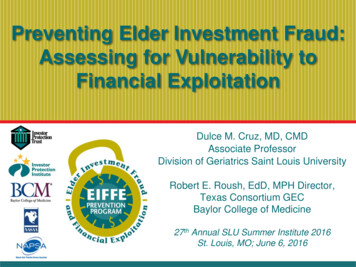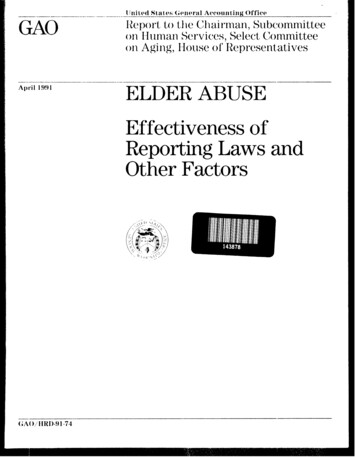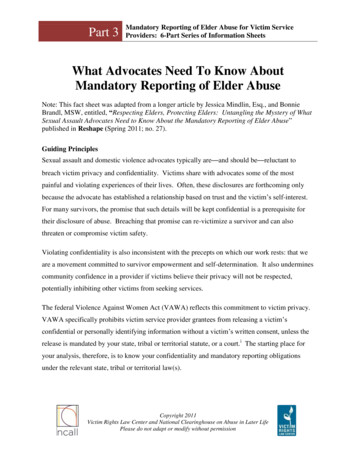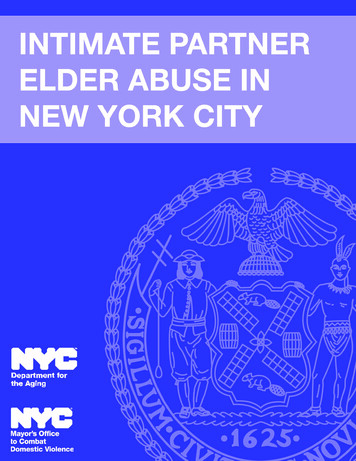
Transcription
INTIMATE PARTNER ELDER ABUSE IN NEW YORK CITYKey Takeaway:Intimate partner elder abuse affects the health and safety of many New Yorkers and their families.Public awareness of the issue and a coordinated multidisciplinary response are required as theNew York City elder population continues to increase.Highlights:Intimate partner elder abuse crime in New York City: In 2016, the NYPD filed 2,857 domestic incident reports (DIRs) for intimate partner elderabuse. In 2016, there were 146 reported felony assaults between intimate partners in which thevictim was 60 years or older. Between 2010 and 2016, there were 23 intimate partner homicides in which the victim was60 years or older.Intimate partner elder abuse at the Family Justice Centers: Between 2010 and 2016, the Family Justice Centers served at least 1,063 clients who wereexperiencing intimate partner elder abuse.Services: The Mayor’s Office to Combat Domestic Violence and the Department for the Aging offer awide range of services for New Yorkers who are experiencing intimate partner elder abuse.Suggested citation: New York City Mayor’s Office to Combat Domestic Violence and the New York CityDepartment for the Aging. Intimate Partner Elder Abuse in New York City. New York City Office of theMayor, 2017.A Joint Research Report from the New York City Mayor’s Office to Combat Domestic Violence and theNew York City Department for the AgingCommissioners: Cecile Noel and Donna M. CorradoThe Mayor's Office to Combat Domestic Violence (OCDV) formulates policies and programs, coordinatesthe citywide delivery of domestic violence services, and works with diverse communities and communityleaders to increase awareness of domestic violence. OCDV collaborates closely with government andnonprofit agencies that assist domestic violence survivors and operates the New York City Family JusticeCenters. These co‐located multidisciplinary domestic violence service centers provide vital social service,civil legal and criminal justice assistance for survivors of intimate partner violence and their children underone roof.For more information on intimate partner violence programs and services in New York City, please visit theOCDV website at nyc.gov/domesticviolence.The Department for the Aging (DFTA) provides essential services for seniors in New York City. It channelsfederal, state, and city funds to community-based organizations that contract with DFTA to provide neededprograms locally throughout the five boroughs. DFTA is proud to include among these services our SeniorCenters. With close to 250 Senior Centers across NYC, including 16 Innovative Senior Centers (ISCs), and 28Naturally Occurring Retirement Community (NORCs), DFTA continues to support these Centers’ activitiesand programs. Moreover, as of this year mental health services have been embedded in 25 of DFTA’ssenior centers. In addition, DFTA provides seniors with home-delivered meals; in-home services such ascase management, friendly visiting and home care; transportation; free legal assistance; an Elderly CrimeVictims Resource Center; community Elder Abuse programs; an Alzheimer’s and Caregiver Resource Center;a Grandparent Resource Center; job training and placement for older adults; volunteering opportunities;services for LGBT seniors and those with vision and hearing loss; as well as crucial services to immigrantsand refugees, who are among NYC’s fastest growing senior population.For more information on elder abuse programs and services in New York City, please visit the DFTA websiteat nyc.gov/aging.
WHAT IS INTIMATE PARTNER ELDER ABUSE?Intimate partner violence is a pattern of abusive behavior that occurs between intimate partnersto gain or maintain power and control. Intimate partners include current or former spouses, datingpartners, and domestic partners as well as people with children in common. Intimate partner violencecan include, but is not limited to, physical, sexual, psychological, and economic abuse. The focus ofthis report, intimate partner elder abuse, is intimate partner violence that occurs among those age 60and older.The 2011 “Under the Radar” report prepared by Lifespan of Greater Rochester, Inc., Weill CornellMedical Center of Cornell University, and the New York City Department for the Aging (DFTA) isthe most recent and comprehensive prevalence study of elder abuse in New York State.i The studyshowed that 76 of every 1,000 New York State residents age 60 and older reported being a victimof elder abuse. Twenty percent of self-reported victims reported that the abuser was their spouse orpartner.Despite clear evidence that the elder community experiences intimate partner violence, limitedresearch has been conducted on the prevalence and dynamics of intimate partner violence amongthis community.ii,iii Additionally, because elder victims of intimate partner violence face additionalbarriers to help-seeking, intimate partner elder abuse may be severely underreported. Researchershave identified a number of internal and external barriers to help-seeking among older womenexperiencing intimate partner violence such as self-blame, powerlessness, a perceived lack of socialsupport, and a belief that no help is available for elder victims.ii,iv Victims with anxiety or depressionoften face additional challenges. In addition to protecting themselves, they may have mental healthsymptoms that undermine their motivation and initiative.v Improved public awareness about intimatepartner elder abuse and the services available could improve reporting and help connect elder victimsof intimate partner violence with appropriate services. What follows is the first ever in-depth look atintimate partner elder abuse in New York City.NEW YORK CITY INTIMATE PARTNER ELDER ABUSE CRIME STATISTICSIn this section, we present recent data on New York City intimate partner crime affecting residentsage 60 and older obtained from the New York Police Department (NYPD)1 and the New York CityOffice of the Chief Medical Examiner (OCME).2Domestic Incident ReportsIn 2016, the NYPD filed 2,857 domestic incident reports (DIRs) for incidents between intimate partnersin which the victim was 60 years or older. These represent about 3% of the total 2016 intimatepartner DIRs for which age was reported (n 83,996). Figure 1 displays a breakdown of the intimatepartner elder abuse DIRs by victim age, victim gender, borough of incident, and perpetrator-victimrelationship. Please note that there may be multiple DIRs between the same victim and/or perpetrator,so the statistics displayed in Figure 1 may include duplicate counts of certain individuals.As shown in Figure 1, intimate partner elder abuse DIRs were most common among victims 60-64years old (47.2%). The majority of intimate partner elder abuse DIR victims were women (57.2%),however 1,221 men were also victims of intimate partner elder abuse DIRs (42.7%). These incidentstook place in all five boroughs, with the most in Brooklyn (31.0%) and Queens (25.9%). The geographicdistribution of DIRs is similar to the American Community Survey 2011-2015 estimated populationdistribution of elder New Yorkers by borough.vi Most of the incidents occurred between spouses(59.4%), but many also occurred between dating partners (27.6%).12Data on domestic incident reports and felony assaults are preliminary and subject to further revision by the NYPD.Data on victim race and victim country of origin for intimate partner elder abuse homicides were obtained through a review of OCMErecords conducted by staff at the Mayor’s Office to Combat Domestic Violence.
Felony AssaultsIn 2016, there were 146 reported felony assaults between intimate partners in which the victim was 60years or older. Again, these represent about 3% of the total 2016 intimate partner felony assaults forwhich age was reported (n 4,992). Figure 1 displays a breakdown of the intimate partner elder abusefelony assaults by victim age, victim gender, borough of incident, and perpetrator-victim relationship.Intimate partner elder abuse felony assaults were most common among victims 65-74 years old(50.7%). In contrast to the gender breakdown of intimate partner elder abuse DIRs, most victims ofthese felony assaults were men (55.5%). The felony assaults took place in all five boroughs with ahigher proportion in the Bronx compared with intimate partner elder abuse DIRs (22.6% vs. 15.5%).Most of the felony assaults occurred between dating partners (54.8%). The remainder was betweencurrent or former spouses (45.2%).HomicideBetween 2010 and 2016, there were 23 intimate partner homicides of victims age 60 or older. Theserepresent 9% of the total intimate partner homicides over this time period (n 253). Figure 1 displays abreakdown of the homicides by victim age, victim gender, borough of incident, and perpetrator-victimrelationship.Most victims of intimate partner elder abuse homicide were between the ages of 60-74 years old(78.3%). Additionally, 78.3% of victims were women. This is in stark contrast to the gender breakdown
of victims of intimate partner elder abuse domestic incidents (43% men, 57% women) and felonyassaults (56% men, 44% women). These 23 homicides took place in all five boroughs, with the highestnumber in Brooklyn (6, 26.1%). The majority of homicides were between spouses (60.9%), with manyalso occurring between dating partners (34.8%).We were able to obtain additional data on the intimate partner elder abuse homicides from the NYPDand through reviewing records obtained from the OCME. Please see Figure 2 below for these additionaldata.Ten of the 23 homicide victims were White (43.5%). The data also show that the majority of homicidevictims were foreign-born (65.2%). The victim and perpetrator had prior DIRs in their police record inonly six of the 23 homicides (26.1%). Five of the 23 homicides (21.7%) were murder-suicides (homicidesafter which the perpetrator committed suicide). This is a relatively high rate of murder-suicide as only14.2% of all intimate partner homicides over this time period (2010-16) were murder-suicides. Finally, themost common homicide method was blunt trauma (39.1%).It is important to note that for intimate partner DIRs and felony assaults, elder abuse cases comprisedjust 3% of all cases. However, with regards to intimate partner homicide, that percentage increasesto 9%. This further suggests that intimate partner elder abuse may be underreported and underacknowledged in New York City until it becomes lethal.Please see the Appendix for data comparing intimate partner elder abuse crime to intimate partnercrime among victims age 59 and younger.
SERVICESFamily Justice Center Client ProfileThe New York City Family Justice Centers (FJCs)provide comprehensive civil legal, counseling,and supportive services for survivors of intimatepartner violence, including those in the eldercommunity who are experiencing intimate partnerviolence or other forms of elder abuse. Between2010 and 2016, the FJCs served at least 1,063unique clients who were experiencing intimatepartner elder abuse. Over this time period, 87,611unique clients visited a FJC and completedthe screening process. Of these, 36,207 clients(41.3%) were missing information on age or theirrelationship with the abuser, so we could notdetermine if any of these clients were intimatepartner elder abuse clients. Thus, it is likely thatmore than 1,063 intimate partner elder abuseclients visited a FJC. Figure 2 displays descriptivestatistics about the 1,063 clients who definitivelyvisited a FJC for intimate partner elder abuseservices. Please see the Appendix for details onmissing data.As shown in Figure 2, a majority of intimatepartner elder abuse clients (57.9%) were 6064 years old and a large majority (80.1%) werewomen. About one-third of clients (32.7%)identified as Hispanic or Latino and another third(31.4%) identified as Black. The Brooklyn FJC sawthe largest number of clients while Staten Islandsaw the fewest.3In addition to these demographic data, we foundthat on average, intimate partner elder abuseclients each had 4.6 visits to a FJC. Their topneeds as identified through the client screeningprocess were 1) safety planning, 2) civil legalservices, 3) counseling services, and 4) permanenthousing. These were the same top needs identifiedby other intimate partner violence clients age 59and younger.Comparative AnalysesIn the following section, we take a closer look atthe profile of these 1,063 unique intimate partnerelder abuse clients and compare them with theintimate partner violence clients who are age 59and younger (n 47,384). For each characteristic,we present a breakdown among intimate partnerelder abuse clients (60 and older) and among theother intimate partner violence clients (59 andyounger). We also calculate a prevalence ratio(the probability of a given characteristic amongclients 60 and older divided by the probabilityof said characteristic among clients 59 andyounger), a 95% confidence interval (CI), and thecorresponding p-value.3The Manhattan Family Justice Center opened in March 2014 and the Staten Island Family Justice Center opened in June 2016
GenderAs shown, 18.2% of clients 60 and older weremen compared to 4.2% of clients 59 and younger.Thus, intimate partner elder abuse clients wereover four times more likely to be men comparedto younger intimate partner violence clients.Disability StatusAs shown, 43.2% of clients 60 and older reporteda disability compared to 11.5% of clients 59 andyounger. Thus, intimate partner elder abuseclients were over three times more likely to reportliving with a disability compared to youngerintimate partner violence clients.Country of OriginAs shown, 68.6% of clients 60 and older wereborn outside the U.S. compared to 56.5% ofclients 59 and younger. Thus, intimate partnerelder abuse clients were 20% more likely to beforeign-born compared to younger intimatepartner violence clients.Primary LanguageAs shown, 48.2% of clients 60 and older had anon-English primary language compared to 41.8%of clients 59 and younger. Similar to country oforigin, intimate partner elder abuse clients were15% more likely to have a non-English primarylanguage compared to younger intimate partnerviolence clients.
Open Family Court CaseAs shown, 16.1% of clients 60 and older had anopen case in family court compared to 23.9% ofclients 59 and younger. Thus, intimate partnerelder abuse clients were 30% less likely to havean open family court case compared to youngerintimate partner violence clients.Police CalledAs shown, the police had been called for 51.2% ofclients 60 and older compared to 66.9% of clients59 and younger. Thus, intimate partner elderabuse clients were 20% less likely to have had thepolice called in relation to their case compared toyounger intimate partner violence clients.Open Criminal Court CaseAs shown, 27.1% of clients 60 and older had anopen case in criminal court compared to 50.4%of clients 59 and younger. Thus, intimate partnerelder abuse clients were about half as likely tohave an open criminal court case compared toyounger intimate partner violence clients.
Overview of services available in NYCAs mentioned above, the New York City Family Justice Centers (FJCs) provide comprehensive civillegal, counseling and supportive services for survivors of domestic violence, elder abuse and sextrafficking. Located in all five boroughs, the FJCs are safe, caring environments that provide one-stopservices and support. Key City agencies, community, social and civil legal services providers, andDistrict Attorney's Offices are located on-site at the FJCs to make it easier for survivors to get help.Services are free and confidential. All are welcome regardless of language, income, or immigrationstatus.In addition, the New York City Department for the Aging (DFTA) together with its community basedelder abuse partners provide direct services to victims of elder abuse, as well as develop preventionactivities that include trainings and outreach. There are elder abuse funded programs in each ofthe boroughs. These contracted agencies provide long-term case management services to clients,many of whom present highly complex cases. Providers may assist victims of elder abuse by helpingthem secure orders of protection; providing long-term counseling; accompanying victims to court;examining powers of attorney and other legal documents; working with police to place victims onhigh-propensity lists; and working closely with District Attorneys to aid in the prosecution of cases.Programs have attorneys on staff to provide legal services on behalf of clients. These programs can bereached by calling 311.As an initiative of Mayor Bill de Blasio’s Domestic Violence Task Force, DFTA will expand its ProvidingOptions to Elderly Clients Together (PROTECT) program. DFTA and the Weil Cornell Medical Centerhave partnered to develop PROTECT, an evidence-based program that provides combined social workand mental health intervention to elder abuse victims. The City will expand PROTECT by offering theprogram to clients of DFTA’s existing borough-based elder abuse programs. PROTECT will be offeredin English and Spanish.Additionally, DFTA has entered into contract with the Weill Cornell New York City Elder Abuse Center,to implement a citywide Multi-Disciplinary Team (MDT) initiative to enhance services to victims ofelder abuse. Each MDT will bring together all of the key entities in their borough(s) that work withagencies serving victims of elder abuse in an effort to coordinate services in cases of elder abusethat have a high degree of difficulty and that require a multi-agency response. These teams comprisegroups of professionals from diverse disciplines who come together to provide comprehensiveassessment and consultation on abuse cases. The teams function as a problem solving group forindividual cases and create a wider, community-based approach to handling elder abuse.CONCLUSIONIntimate partner elder abuse is an issue that impacts many New Yorkers and their families. Intimatepartner violence is associated with a number of short- and long-term physical and mental healthconsequences. These consequences can have more severe impacts on elder victims whose health orautonomy may already be compromised.vii The data presented in this report represent the first ever indepth look at intimate partner elder abuse. As such, further research is needed to better understandthe causes and consequences of this social problem. For example, additional research could helpilluminate the mechanisms behind the observed trends in intimate partner elder abuse by gender.The elder community New York City represents one of the fastest growing communities in the City.The New York City Department of City Planning projects that the population of residents 65 andolder will increase from 1,002,208 in 2010 to 1,177,215 in 2020, representing a 17% increase.vii Theprojected population size of this demographic in 2040 is 1,409,708, representing a 41% projectedincrease over 30 years. As the size of the elder community continues to increase in New York City,it is critical that we increase public awareness of intimate partner elder abuse and improve linkagesto service providers. As described above, intimate partner elder abuse is a complex issue involvingmany disciplines including healthcare, law, social services, and public safety. It therefore requiresa coordinated multidisciplinary, multi-agency, and multi-system response. OCDV and DFTA arededicated to working collaboratively to have a positive impact on victim service provision.If you or anyone you know is experiencing domestic violence, call 311 and ask for the City’s 24-hourDomestic Violence Hotline or to be referred to a community based elder abuse provider in yourborough.
APPENDIXAPPENDIXTable 1. New York City Intimate Partner Crime by Age CategoriesDomestic Incident Reports (2016)Victim age 60 and olderVictim age 59 and 3,86881,13948.0%27.6%19.6%4.8%Victim GenderBoroughRelationshipTOTALVictim GenderBoroughRelationshipTOTALVictim QueensStaten IslandDating partnerSpouseEx-dating 857Felony Assaults (2016)Victim age 60 and olderCountPercentageVictim age 59 and tanQueensStaten 4477.5%22.0%0.0%0.4%Dating partnerSpouseEx-dating es (2010-16)Victim age 60 and olderCountPercentageVictim age 59 and 23.5%
RelationshipVictim RaceVictim Country of OriginPrior DIRsMurder-suicideHomicide MethodTOTALStaten Island417.4%114.8%Dating partnerSpouseEx-dating partnerEx-spouseChild in 027161.3%22.6%3.9%0.0%11.7%0.4%AsianBlackHispanic or LatinoWhite6431026.1%17.4%13.0%43.5%Data not availableData not availableData not availableData not %13.0%Data not availableData not availableData not Blunt .0%2.6%
Table 2. 2010-16 New York City Intimate Partner Family Justice Center Clients by Age CategoriesFamily Justice Center Clients (2010-16)Client age 60 and olderClient age 59 and youngerCountPercentageCountPercentageVictim Missing or 3431.4%17,65137.3%Hispanic or taten Dating -dating partner10.1%610.1%Ex-spouse958.9%2,1614.6%Child in common323.0%14,61630.8%Currently or formerly living together10810.2%4,3359.1%Living with 5%Missing153excluded9,954excludedCountry of ry LanguageEnglish51248.2%19,80541.8%Not English55151.8%27,57758.2%Missing02excludedOpen Family Court ing127excluded9,391excludedPolice issing108excluded7,328excludedOpen Criminal Court CaseYes27327.1%22,65050.4%4Gender options other than man and woman were added in 2016
7,38449.6%excludedLifespan of Greater Rochester, Inc., Weill Cornell Medical Center of Cornell University, and New York City Department of Aging.(May 2011). Under the Radar: New York State Elder Abuse Prevalence Study.iiBeaulaurier RL, Seff LR, Newman FL. (2008). Barriers to Help-Seeking for Older Women Who Experience Intimate Partner Violence:A Descriptive Model. Journal of Women & Aging, 20(3/4):231-48.iiiWilke DJ & Vinton L. (2003). Domestic Violence and Aging: Teaching about their Intersection. Journal of Social Work Education,39(2):225-35.ivBeaulaurier RL, Seff LR, Newman FL, Dunlop B. (July 2007). External Barriers to Help Seeking for Older Women Who ExperienceIntimate Partner Violence. Journal of Family Violence, 22(4):747-55.vSirey JA, Berman J, Salamone A, Raue P. (January 2015). Feasibility of Integrating Mental Health Screening and Services Into RoutineElder Abuse Practice to Improve Client Outcomes. Journal of Elder Abuse & Neglect, 27(3):254-69.viU.S. Census Bureau, 2011-2015 American Community Survey 5-Year Estimates.viiParanjape A, Sprauve-Holmes NE, Gaughan J, Kaslow NJ. (2009). Lifetime Exposure to Family Violence: Implications for the HealthStatus of Older African American Women. Journal of Women’s Health, 18(2):171-5.viiiNew York City Department of City Planning. (December 2013). New York City Population Projections by Age/Sex & Borough, 20102040.New York City Office of the Mayor.
the most recent and comprehensive prevalence study of elder abuse in New York State.i The study showed that 76 of every 1,000 New York State residents age 60 and older reported being a victim . partner elder abuse and the services available could improve reporting and help connect elder victims of intimate partner violence with appropriate .
